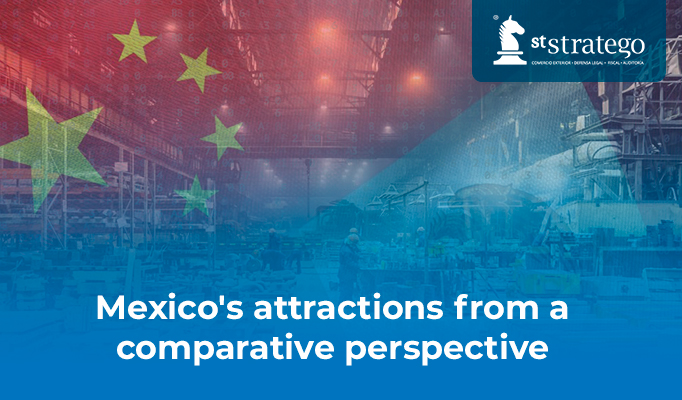China – Mexico
In spite of having great political and economic differences, a comparison with this country was considered because of Mexico’s direct competition as a manufacturing country.
Based on information provided by the “Atlas of Economic Complexity” (2020), China is an upper-middle-income country and ranks as the 47th richest economy per capita of the 133 economies studied. Its 1.41 billion people have a GDP per capita of $10,434, with GDP per capita growth of 5.3% over the past five years. China ranks as the 17th most complex country in the Economic Complexity Index (ECI) ranking.
On the other hand, Mexico is an upper-middle income country, ranking as the 56th richest economy per capita. Its 129 million inhabitants have a GDP per capita of $8,329 and its GDP per capita growth averaged -1.5% over the last five years.
Mexico ranks as the 20th most complex country in the Economic Complexity Index (ECI), dropping 2 positions in this decade. Mexico’s declining complexity has been driven by a lack of export diversification.
Growth projections are moderate for both countries. The Growth Lab forecasts growth in Mexico at 3.1% per year and for China at 5.8% per year over the next decade, ranking in the top decile of the rest of the countries.
Some of the comparative variables that we will address in this article include:
Labor costs:
Currently, Mexico has a very attractive “advantage” for different investors, as Mexican labor is 45% cheaper than Chinese labor. According to the article “Nearshoring, a long line in Mexico”, the salary of a Chinese maquiladora worker is 5.23 dollars per hour, while a Mexican gets 2.90 dollars per hour.
International companies seek to settle in countries where they have cheaper production factors to maximize their profits, since they minimize costs. That is why Mexico has become one of the main countries for companies that make intensive use of labor for exports.
Skilled labor
Highly skilled labor increases production and facilitates the operation of advanced technology, which means profit maximization, since the investor does not have to invest more in training its workers. Companies from the United States, Japan, the European Union and East Asia, which are the main investors in Mexico and China, make considerable use of skilled labor. Thus, the greater availability of this type of labor force in Mexico gives it an advantage over the Asian country. Likewise, skilled labor costs in Mexico are relatively low by international standards.
Infrastructure
Another important point that makes these countries attractive is their infrastructure. In recent years, both countries have implemented huge projects in a gradual and planned manner in infrastructure for railroads, airports, highways, telecommunications, ports, among many others. In Mexico, the government of this six-year term has promoted two investment projects in the logistics sector with the objective of improving the national railway system in the southeast of the country to reduce costs and times for the movement of goods and passengers. First, the Interoceanic Corridor of the Isthmus of Tehuantepec will link the ports of Coatzacoalcos in Veracruz and Salina Cruz in Oaxaca through 317 kilometers of railroad tracks, thus benefiting the transfer of industrial, oil and forestry products. Second, the Mayan Train project will interconnect the main cities and tourist areas in the southeast of the country through 1,500 km of new railroad tracks in Chiapas, Tabasco, Campeche, Yucatan and Quintana Roo. This project, in addition to boosting regional economic development, will save up to 45% in passenger travel time.
As of July 2022, another 25 projects are under execution and 16 more have already been authorized to start construction. Investment in these projects represents more than 70% of planned investments, and of the 25 projects underway, 10 are already more than 80% complete. The Siervo de la Nación Urban Highway project, the Circuito Exterior Mexiquense, and the Mexico-Tepexpan Highway, which is one of the connectivity projects for the Felipe Ángeles International Airport (AIFA), stand out. Also noteworthy are the Santa Catarina Viaduct in the urban area of Monterrey, Caminos del Sur in the State of Mexico, Paquete Pacífico Sur (Guadalajara-Tepic Highway, Guadalajara and Tepic South Freeway) and the Compostela Highway.
Geographical location
According to Statista, the United States (2020) is the largest importer in the world, with imports of 2,407.55 billion dollars. Due to its geographic proximity with Mexico and the 50 ports of entry with the United States, the logistics of the settled companies are improved. The United States is also the main importer of Mexican products with 88.4%, a competitive advantage for companies to locate their production in our country, due to the low investment requirements in inventories, transaction costs, transportation costs and fast shipments. In fact, it is important to mention that a cubic meter of merchandise shipment from China to the United States costs US$140, while shipping from Mexico costs US$10 per cubic meter.
It should also be noted that Mexico, compared to the countries shown below, takes less time to travel to its destination.
For China, its proximity to Japan, South Korea, Taiwan, Hong Kong, among others, allows it to participate in one of the most dynamic economic regions in the world with the same advantages as Mexico, but in that region.
Natural resources
The two countries can offer foreign companies an immense amount of natural resources for use in production processes at relatively low costs (water, electricity, coal, steel, land, copper and oil).
But it is important to take into account that China has presented a strongly degraded environmental situation in many large cities. Although it should not be overlooked that Mexico has suffered a shortage of water, electricity supply and the lack of industrial land so much in demand in recent years.
Resources for investment
The economic progress of any country requires companies to invest in productive projects. In this last quarter, Mexico registered a record and annual increase of 13%, surpassing last year’s annual investment by 3,706.3 million dollars. The pandemic and the reinstallation of companies from China have greatly favored the entry of these new investments into the country, as well as the different treaties and laws that the neighboring country has applied, such as the “Chip Act”, where the companies benefiting from the CHIPS Bill will be prohibited from investing for a period of 10 years in China and other countries that represent a threat to the United States, so it is about redefining its global strategy, which means more opportunities for Mexico. This, together with the different programs such as IMMEX, PROSEC and the dynamism of the secretariats that facilitate the installation of interested parties.
Mexico can thus continue to take advantage of China’s notorious weaknesses such as its ever-changing legal environment, administrative complexity, lack of transparency, corruption and weak intellectual property protection, as well as its cultural differences in business practices.
Macroeconomic environment
The stability of a country’s macroeconomic variables can undoubtedly attract new foreign capital for productive use. In recent decades, both countries have presented very diverse macroeconomic variables.
In both countries the external debt is over 50%, for Mexico it is 57.53% and for China it was 68.05% of its GDP. Regarding their unemployment rate the situation is as follows, China has two percent less unemployed, Mexico has an unemployment rate of 4.3%.
Within the inflation variable, Mexico is well above Chinese inflation, as they have values of 8.41% and 2.1% respectively.
After a period as grim as the Covid-19 pandemic was or still is, the impact has continued to leave a lasting impact on the industrial sector, with China being one of the first places to experience this difficult crisis, with a record drop in industrial production, retail sales and fixed asset investment, which, added to other indices, anticipates a collapse in multiple areas, according to a report presented by the National Bureau of Statistics of China. According to experts, the data reveal the scale of the damage caused by the new SARS-CoV-2 coronavirus, raising fears of a global recession.
Industrial production in China fell by 2.9% year-on-year in April this year, marked by the harsh restrictions imposed under the zero COVID policy by the country’s authorities in the face of the worst outbreaks. Overall, the manufacturing sector contracted by 4.6% and the automotive sub-sector was one of the industries that suffered a severe contraction of -43.5%. Even though it has been a few years since the outbreak, it can be seen that the Chinese economy has had difficulties in its recovery, due to resurgences and nearshoring.
On the other hand, the Mexican economy has had a moderate performance, in September 2022 the industrial sector decreased by 0.2% at a monthly rate according to INEGI. The manufacturing sector presented an increase of 8.3%, up to September of this year, and an increase in the automotive sector production of 15.3%.
Considering each of the points mentioned above, we can conclude that greater FDI in Mexico and/or Latin America can help reduce global dependence on Chinese manufacturing, as long as the cost-benefit ratio is in favor of the region, as well as continuing to generate conditions for the installation of new industries, including socio-political factors.
This document does not constitute a particular consultation, and therefore, Asesores Stratego SC, is not responsible for the interpretation or application given to it. The total or partial reproduction of this publication, by any means or procedure, is prohibited without the prior, express and written authorization of the author. Any form of unauthorized use will be prosecuted in accordance with the provisions of the Federal Copyright Law. We are at your service to answer your questions or comments, for more information on this subject and our services, please contact us at: info@asesores-stratego.com
or application given to it. The total or partial reproduction of this publication, by any means or procedure, is prohibited without the prior, express and written authorization of the author. Any form of unauthorized use will be prosecuted in accordance with the provisions of the Federal Copyright Law. We are at your service to answer your questions or comments, for more information on this subject and our services, please contact us at: info@asesores-stratego.com





